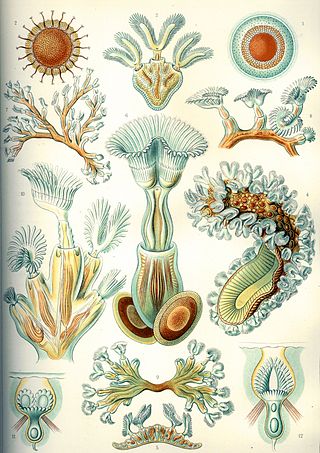
Bryozoa are a phylum of simple, aquatic invertebrate animals, nearly all living in sedentary colonies. Typically about 0.5 millimetres long, they have a special feeding structure called a lophophore, a "crown" of tentacles used for filter feeding. Most marine bryozoans live in tropical waters, but a few are found in oceanic trenches and polar waters. The bryozoans are classified as the marine bryozoans (Stenolaemata), freshwater bryozoans (Phylactolaemata), and mostly-marine bryozoans (Gymnolaemata), a few members of which prefer brackish water. 5,869 living species are known. At least two genera are solitary ; the rest are colonial.
Stenolaemata are a class of exclusively marine bryozoans. Stenolaemates originated and diversified in the Ordovician, and more than 600 species are still alive today. All extant (living) species are in the order Cyclostomatida, the third-largest order of living bryozoans.

Cheilostomatida, also called Cheilostomata, is an order of Bryozoa in the class Gymnolaemata.

Cyclostomatida, or cyclostomata, are an ancient order of stenolaemate bryozoans which first appeared in the Lower Ordovician. It consists of 7+ suborders, 59+ families, 373+ genera, and 666+ species. The cyclostome bryozoans were dominant in the Mesozoic; since that era, they have decreased. Currently, cyclostomes seldom constitute more than 20% of the species recorded in regional bryozoan faunas.

A zooid or zoöid is a single animal that is part of a colonial animal. This lifestyle has been adopted by animals from separate unrelated taxa. Zooids are multicellular; their structure is similar to that of other solitary animals. The zooids can either be directly connected by tissue or share a common exoskeleton. The colonial organism as a whole is called a zoon, plural zoa.
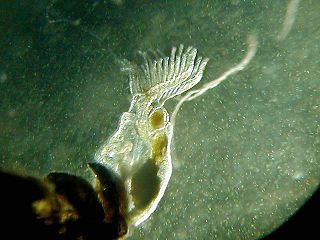
Phylactolaemata is a class of the phylum Bryozoa whose members live only in freshwater environments. Like all bryozoans, they filter feed by means of an extensible "crown" of ciliated tentacles called a lophophore, and like nearly all bryozoans, they live in colonies, each of which consists of clones of the founding member. Unlike those of some marine bryozoans, phylactolaemate colonies consist of only one type of zooid, the feeding forms known as autozooids. These are supported by an unmineralized "exoskeleton" made of gelatinous material or protein, secreted by the zooids. The class contains only one extant order, Plumatellida.
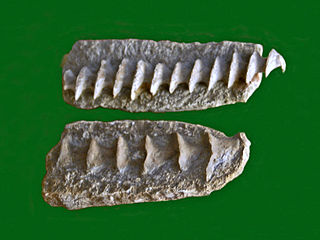
Archimedes is a genus of bryozoans belonging to the family Fenestellidae. The first use of the term "Archimedes" in relation to this genus was in 1838.
Fenestrata is an extinct order of bryozoan, dating from the Upper Arenig. Most fenestrate bryozoans formed net-like colonies, often in funnel- or fan-shaped forms, with a single layer of zooids facing one direction. The colony shape served as a filter-feeding apparatus that water currents flowed through, with autozooecial apertures only on the side of the colony facing into the current. This colony structure was vulnerable to predators, so some fenestrate bryozoans produced skeletal superstructures, likely to strengthen or protect the colony, and others had protective spines surrounding their autozooecial apertures.

Conopeum seurati is a species of colonial bryozoan in the order Cheilostomatida. It is native to the northeastern Atlantic Ocean, the North Sea and the Mediterranean Sea. This species has been introduced to New Zealand and Florida.
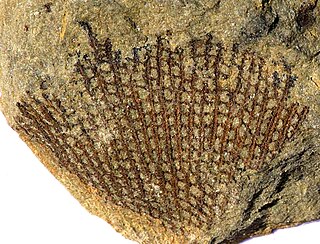
Fenestella is a genus of bryozoans or moss animals, forming fan–shaped colonies with a netted appearance. It is known from the Middle Ordovician to the early Upper Triassic (Carnian), reaching its largest diversity during the Carboniferous. Many hundreds of species have been described from marine sediments all over the world.

Bugula neritina is a cryptic species complex of sessile marine animal in the genus Bugula. It has a practically cosmopolitan distribution, being found in temperate and tropical waters around the world, and it has become an invasive species in numerous locations. It is often found in hard substrates, such as rocks, shells, pillars and ship hulls, where it can form dense mats, contributing to biofouling. B. neritina is of biomedical interest because it harbors a bacterial symbiont that produces a group of bioactive compounds with potential applications in the treatment of numerous diseases.

Electra posidoniae is a species of bryozoan in the family Electridae. It is endemic to the Mediterranean Sea, and is commonly known as the Neptune-grass bryozoan because it is exclusively found growing on seagrasses, usually on Neptune grass, but occasionally on eelgrass.
Callopora lineata is a species of colonial bryozoan in the family Calloporidae. It is found on rocky shores in the Atlantic Ocean and the Mediterranean Sea.
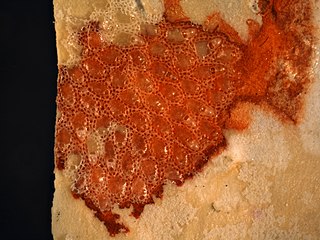
Chorizopora brongniartii is a species of bryozoan in the family Chorizoporidae. It is an encrusting bryozoan, the colonies forming spreading patches. It has a widespread distribution in tropical and temperate seas.
Monticulipora is an extinct genus of Ordovician bryozoans belonging to the family Monticuliporidae. It was first named in 1849, and its description was published the following year by French paleontologist Alcide M. d'Orbigny, making it one of the earliest bryozoans to be recognized in science. It is still one of the most widespread fossil bryozoan genera. Though colonies that grow in masses made of multiple layers are characteristic of the genus, its colonies have varying shapes, able to be encrusting, branching, massive, or frond-like, and are covered in monticules (bumps). Most Monticulipora species have distinctively granular walls, and Monticulipora and can be distinguished from Homotrypa by the presence of axial diaphragms.
Homotrypa is an extinct genus of bryozoans from the Ordovician and Silurian periods, known from fossils found in the United States. Its colonies are branch-like and have small monticules made of groups of three or four larger zooecia slightly protruding out from the main surface of the colony. In cross section, the zooecia are erect in axis and gently curve toward the surface of the colony.
Stenopora is an extinct genus of bryozoans first described in 1845, using material collected by Charles Darwin. Its colonies can be branching, frondescent, encrusting, or massive, and shapes display variation even within single colonies. Diaphragms are absent and acanthostyles of uniform size surround its zooecial apertures.
Prasopora is an extinct genus of bryozoan belonging to the family Monticuliporidae, known from the Middle Ordovician. Its colonies were disc-shaped or hemispherical, flat on bottom and convex on top, and had very abundant mesopores; in the case of the species P. insularis its zooecia were isolated from each other by the numerous mesopores surrounding them. It is very similar to the genus Monticulipora, and some bryozoan species have been assigned to both genera at different points in their study, but it is mostly distinguished by having more mesozooecia, rounder autozooecial apertures, relatively few acanthostyles and diaphragms and cystiphragms equally distributed in the autozooecia.
Cyphotrypa is an extinct genus of Ordovician bryozoan. Its colonies form hemispherical shapes, with flat undersides and rounded tops. In cross-section, the zooecia fan out from the initial growth area and intersect the rounded top surface of the colony at right angles. A few scattered maculae are present, composed of a few zooecia larger than the others with mesopore-like apertures.
Lichenalia is an extinct genus of cystoporate bryozoan belonging to the family Rhinoporidae. It is known from the Upper Ordovician to the Middle Silurian periods, which spanned from approximately 460 to 430 million years ago. The genus had a cosmopolitan distribution, with fossil specimens found in various regions of the world, including North America, Europe, and Asia.











